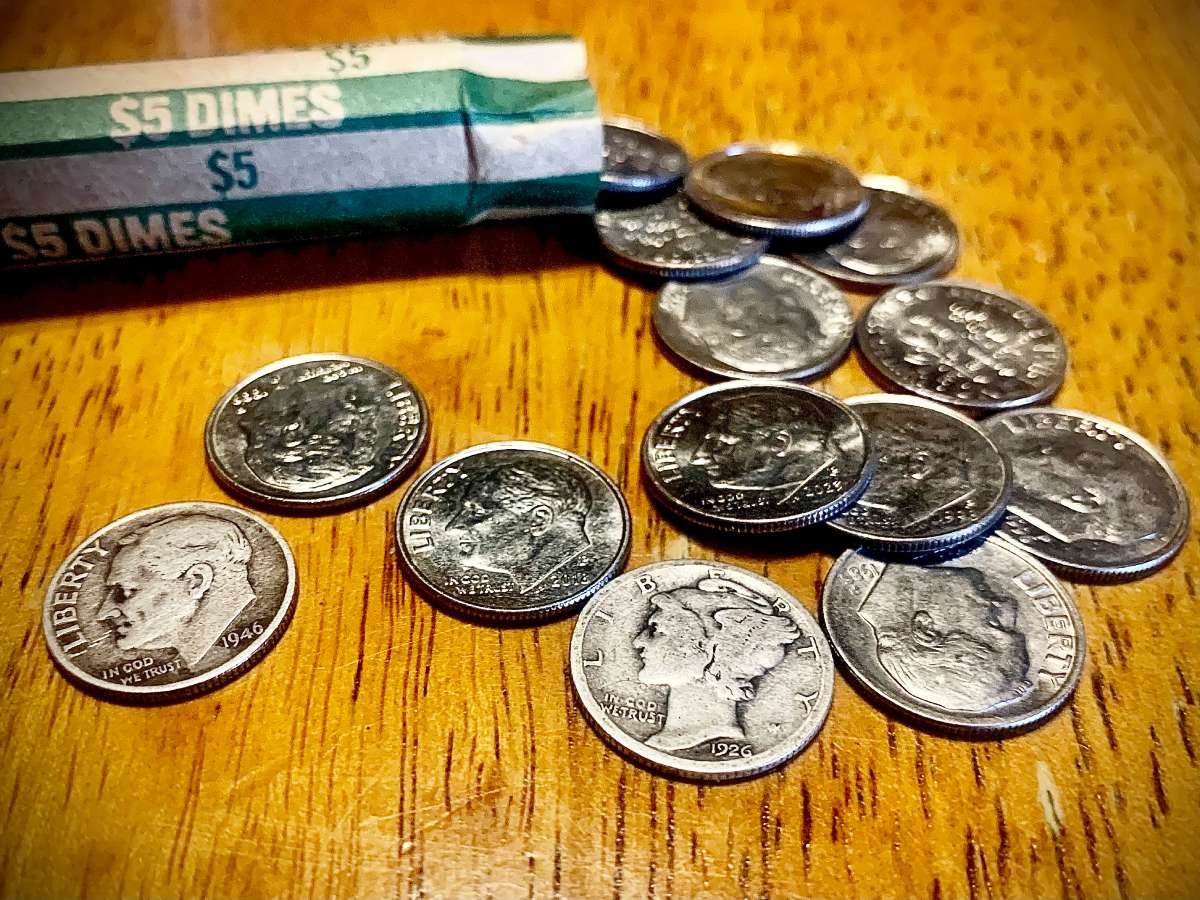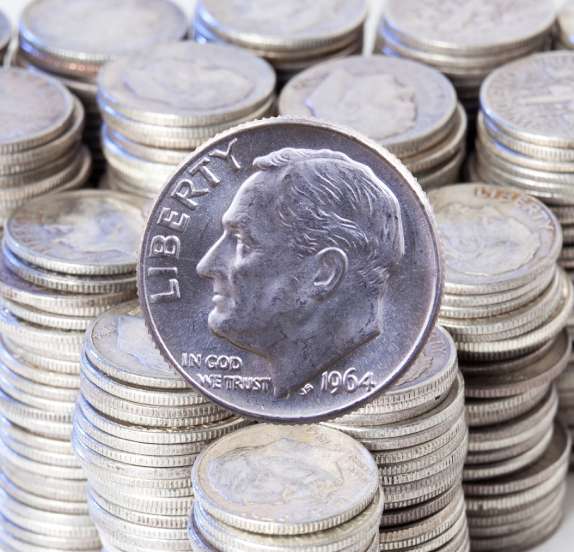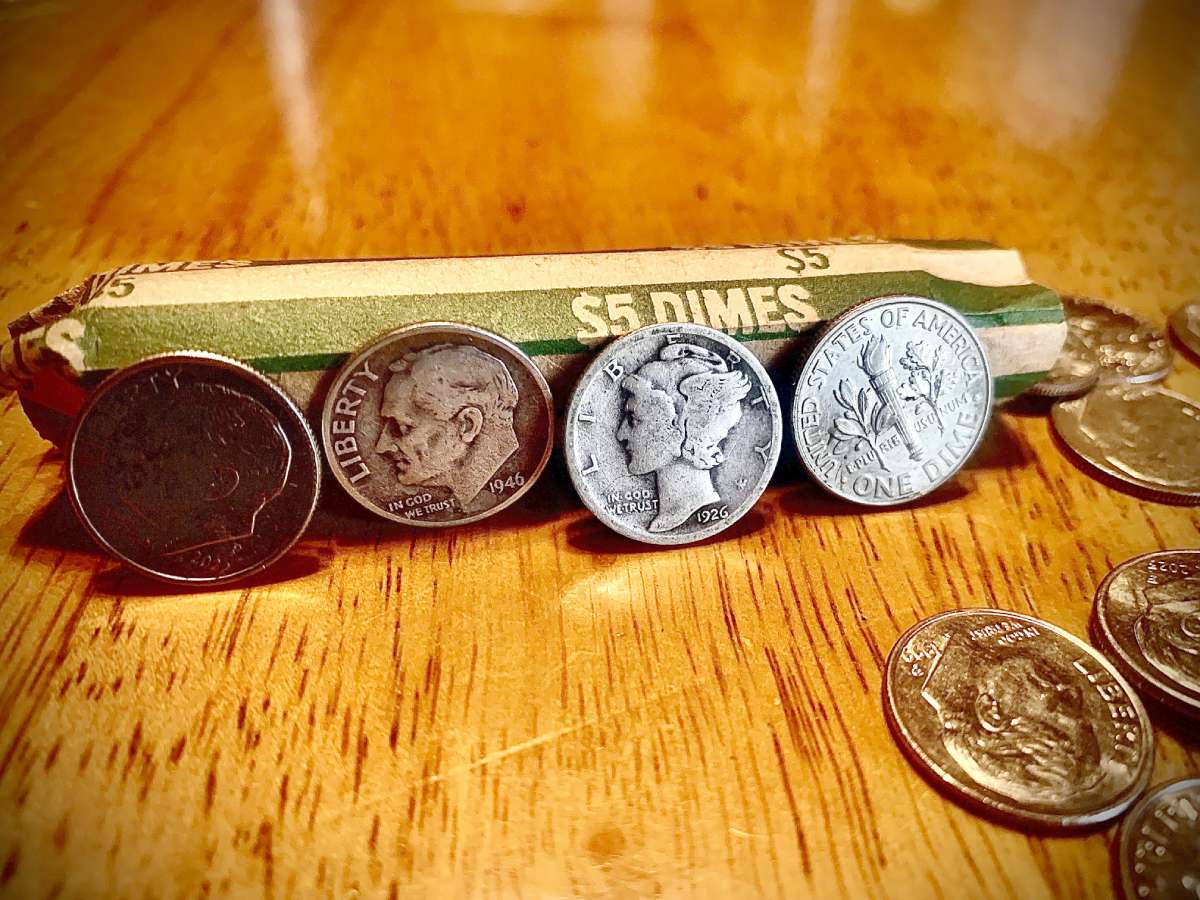Dime Roll Hunting 101
I find searching through rolls of dimes for rare coins worth money a valuable use of my time. I’ve been doing this for years.
The question I most often get when people find out I search dime rolls is, “Which dimes should I look for?”

That’s not always an easy question to answer. After all, there are many rare and valuable dimes you can potentially find in coin rolls.
Here’s a list of all the places you can buy rolls of dimes.
What To Expect When Searching Rolls Of Dimes
First things first… The thing I always tell people who search rolls for rare and valuable coins is to manage your expectations.
There are so many coin collecting reels and videos out there hyping up rare dimes and other valuable finds you can make when hunting dime rolls. They may lead you to believe there are riches hiding inside every roll of dimes you open.
The reality is that in most cases you’re not going to turn up anything worth tons of money in any given roll of coins. Valuable dimes are especially tough to find, in my opinion. Why? Because so many people search dime rolls looking for silver. So, you have a lot of competition out there.
But that doesn’t mean you can’t find valuable dimes in rolls. And that’s the point I want you to remember. Every roll of dimes could be a new opportunity to find something worth money, unusual, or just plain ol’ “interesting.”
Which Dimes Are Worth Saving?
There are many different types of dimes worth looking for in rolls.
Here’s a list of dimes to look for coin roll hunting…
Dimes Dated 1964 Or Earlier
Here’s the key, folks: All dimes dated before 1965 (so, 1964 and earlier) are made from silver.
This is probably the most important thing you should be keeping your eye on.

Yes, yes, yes, there are rare and valuable dates, varieties, and errors out there — and I’m going to get into some of those. But the dimes worth keeping that you’re most likely to find in rolls are pre-1965 silver dimes.
There are 3 kinds of pre-1965 dimes you’re most likely to find in coin rolls:
- Silver Roosevelt dimes (1946-1964)
- Mercury dimes (1916-1945)
- Barber dimes (1892-1916)
What are those pre-1965 silver dimes worth?
Their values are always fluctuating based on the current price of silver. So, I recommend you check the current silver price to see how much a pre-1965 silver dime is worth today.
Error Dimes
I receive lots and lots of questions from people who have found what they think are error dimes. But most of these odd coins just show post-mint damage.
That begs the question: What errors should you be looking for?
Here’s a rundown of the 3 error dimes you’re most likely to find when dime roll hunting:
1) Off-Center Dime Errors
When a coin isn’t perfectly centered on the press or the dies that produce the designs on a coin aren’t aligned correctly, you can get an off-center error.
The values of off-center errors vary, depending on how much of the design is missing and whether or not a complete date is visible.
The most valuable type of off-center dime would be one that is missing around half of its design yet still showing a full date. These could be worth over $250. More common off-center dimes are 3% to 5% off, and these have values closer to $15 to $30.
2) Broadstruck Dime Errors
Broadstrikes are cool errors. They occur when the retaining collar, which wraps around the coin as its being struck and imparts the edge reeding (ridges on the side of the coin), fails to deploy. The result is a coin that’s slightly thinner and wider than normal and that doesn’t have any evidence of a formed rim or edge reeding — in the case of a coin that has any.
If you find a broadstruck dime, be sure you hang onto it! Remember, just because you find a dime with no edge reeding does not automatically mean it’s a broadstrike. It will also lack a proper rim and should be a bit thinner and wider than normal. Values for broadstruck dimes generally range from $10 to $25.
3) Die Break Dime Errors
The dies which make coins don’t last forever. A typical dime die might strike about 275,000 dimes before it has to be replaced due to age and wear. Sometimes the die will wear out before it can be replaced.
One of the most drastic signs of an aging die is a type of anomaly known as a die crack or die break. These occur when the die is literally beginning to show cracks or fissures on the surface. This results in a raised line, blob, or other element approximating the shape and size of the crack on the die.
Die crack dime errors vary in value, depending on the size, location, and magnitude of the crack. While some die crack errors are too minor or insignificant to be worth more than face value, others can bring more than $25.
One of the most coveted types of die cracks is known as a cud. A die cud error looks like a flattish blob attached to the rim. Die cuds are often worth $50 to $100.
3 Rare Dimes Worth Big Money
There are a few rare dimes that are worth LOTS of money.
You have a real chance of finding at least two of them in rolls of dimes. The other one looks like a common dime that many people think is extremely rare.

I’m about to tell you what you need to know about these 3 valuable and rare dimes…
#1 – 1965 Silver Dime
A handful of Roosevelt dimes containing silver were dated 1965 — the year dimes were first made from copper-nickel clad. These 90% silver 1965 dime errors are worth more than $3,000 apiece.
So how do you tell a 1965 silver dime apart from a regular clad dime?
You’ve got to weigh it on a gram scale. The silver 1965 dime should tip the scale at around 2.5 grams, while a clad dime weighs only 2.27 grams.
#2 – 1975 No S Proof Dime
This has to be one of the most popular dimes out there.
It’s a 1975 dime that was struck at the San Francisco Mint for proof sets. But… the die that struck at least a few of them failed to carry the essential “S” mintmark indicating the coin’s origin. This one tiny mistake is worth big bucks! One example sold for nearly $500,000 in 2019.
But I want you to remember something: the 1975 No S dime is a proof coin, and it was distributed only in proof sets.
So yes, you will probably find 1975 dimes with no mintmark in coin rolls. HOWEVER… those were made at the Philadelphia Mint to the tune of 585,673,900 pieces.
Your best chance of finding a 1975 No S PROOF dime is in a long-forgotten, unchecked 1975 proof set.
Still, it’s not impossible for you to find a 1975 No S proof dime in rolls these days. If you do… consider yourself extremely lucky because it means that someone broke open their 1975 proof set and spent those coins as money.
#3 – 1982 No Mintmark Dime
Well, after talking about rare dimes worth thousands of dollars, this last one mentioned here might fall flat. It’s worth closer to $100.
But you also have a far better chance of finding one of these dimes in rolls today.
The 1982 No Mintmark dime was struck at the Philadelphia Mint without its “P” mintmark just above the date on the coin. Tens of thousands of these 1982 No Mintmark dimes were likely struck. Many of them first turned up in Sandusky, Ohio — with numerous pieces reportedly found at Cedar Point amusement park.
There are two kinds of 1982 No Mintmark dimes:
- One with a weaker strike
- Another with a stronger strike
The 1982 No Mintmark dime with weak strike is worth between $50 and $75 or more. The 1982 No Mintmark dime with strong strike is worth closer to $100 and up.
I wouldn’t mind pulling a 1982 No Mintmark dime from the next roll of dimes I search through! I bet you’d be pretty stoked to make a find like that as well.
Good luck!
And, if you have any questions about dime roll hunting, remember that you can always drop a line here in the comments below.




